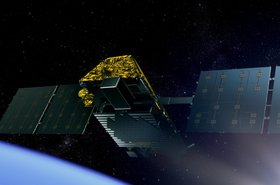The Defense Advanced Research Projects Agency (DARPA) plans to help develop "a burgeoning cislunar and lunar economy," including communications and data storage on the Moon.
The agency has been soliciting help for the 10-Year Lunar Architecture (LunA-10) capability study since the summer, but a recent update provides more information about the program.
"DARPA supports a future model where the National Aeronautics and Space Administration (NASA), international governments, and commercial industry can rapidly scale up lunar exploration and commerce, enabled and supported by the deployment of an efficiently combined, integrated lunar infrastructure framework," the DARPA document states.
"An integrated framework would upend the current technical paradigm, whereby each lunar lander or activity must organically support all required resources such as survival power, communications, and data storage."
Later in the document, it states that specific key sectors that must be developed for a long-term presence on the Moon includes "digital infrastructure for modern lunar computing," as well as "communications."
Projects that could come out of LunA-10 would ideally serve multiple sectors at the same time, DARPA notes. "As one example (of many possible combinations): Energy; Position, Navigation, and Timing (PNT); and communications needs may be combined via a single infrastructural laser system designed to provide optical power beaming, laser communications (lasercom), and PNTOC (PNT over Optical Communications)."
The solutions may not be lunar surface-based, and could also be in orbit.
Separate to the LunA-10 project, Thales Alenia Space is working with NASA to build a data center on the Moon.
If and when the facility is live, it will connect to Nokia's Moon-based cellular network. Both will form part of LunaNet, which we profiled in detail.
The EU is also planning its own lunar telecoms and positioning network, Project Moonlight, while China is already planning lunar deployments.
In the commercial sector, Lonestar Data Holdings plans to deploy small data centers on the Moon.
In an August announcement for LunA-10, Dr. Michael Nayak said: “A large paradigm shift is coming in the next 10 years for the lunar economy. “To get to a turning point faster, LunA-10 uniquely aims to identify solutions that can enable multi-mission lunar systems – imagine a wireless power station that can also provide comms and navigation in its beam.
"For 65 years, DARPA has pioneered and de-risked technologies vital to civil space advancement — from the rocket technology in the Saturn V that took humans to the Moon for the first time, to the recent DARPA-NASA partnership to enable faster space travel to the Moon and beyond with a nuclear thermal rocket engine. LunA-10 continues this rich legacy by identifying and accelerating key technologies that may be used by government and the commercial space industry, and ultimately to catalyze economic vibrancy on the Moon.”
DARPA plans to make the final analytical frameworks for lunar infrastructure available to the public.




